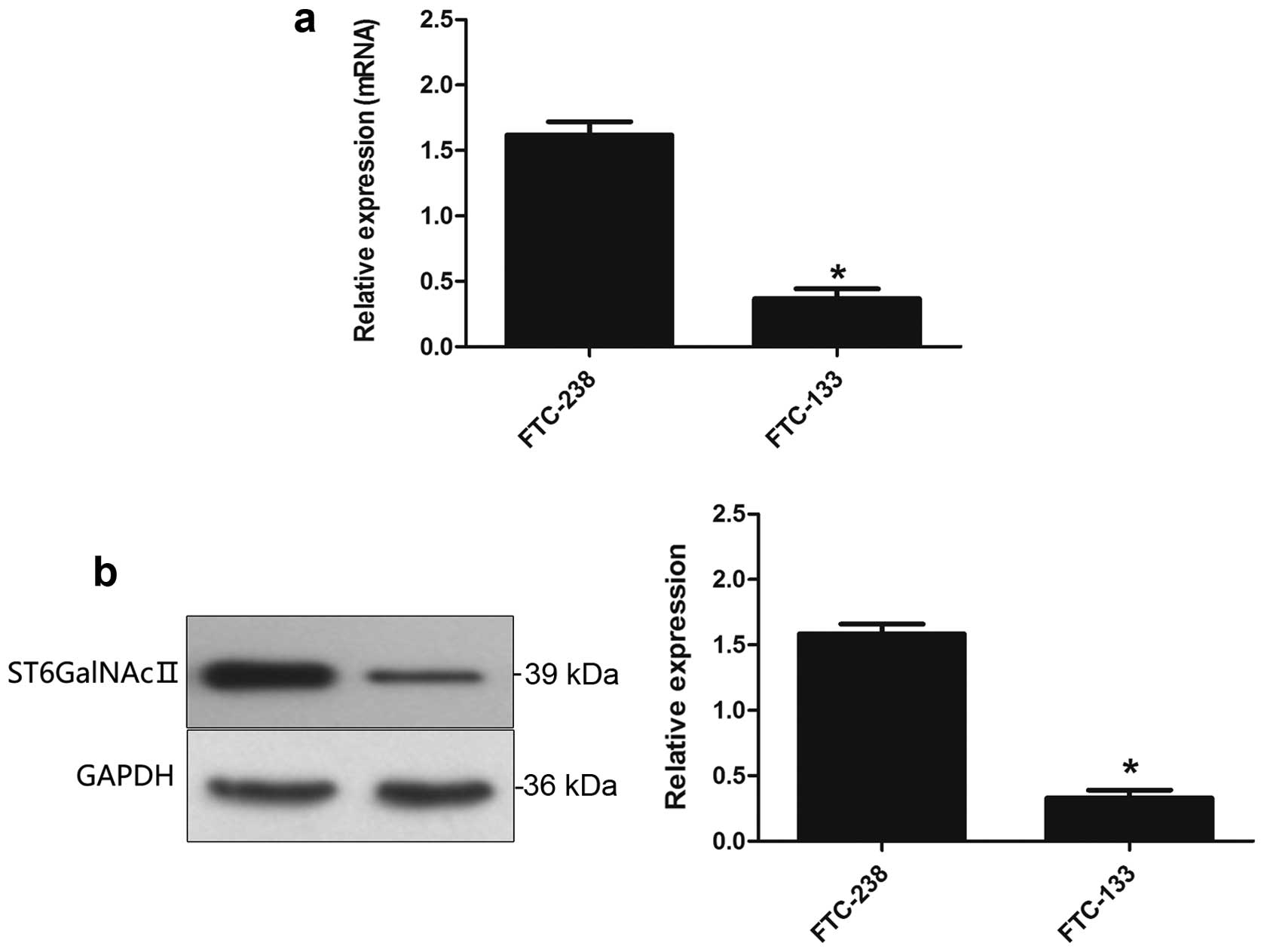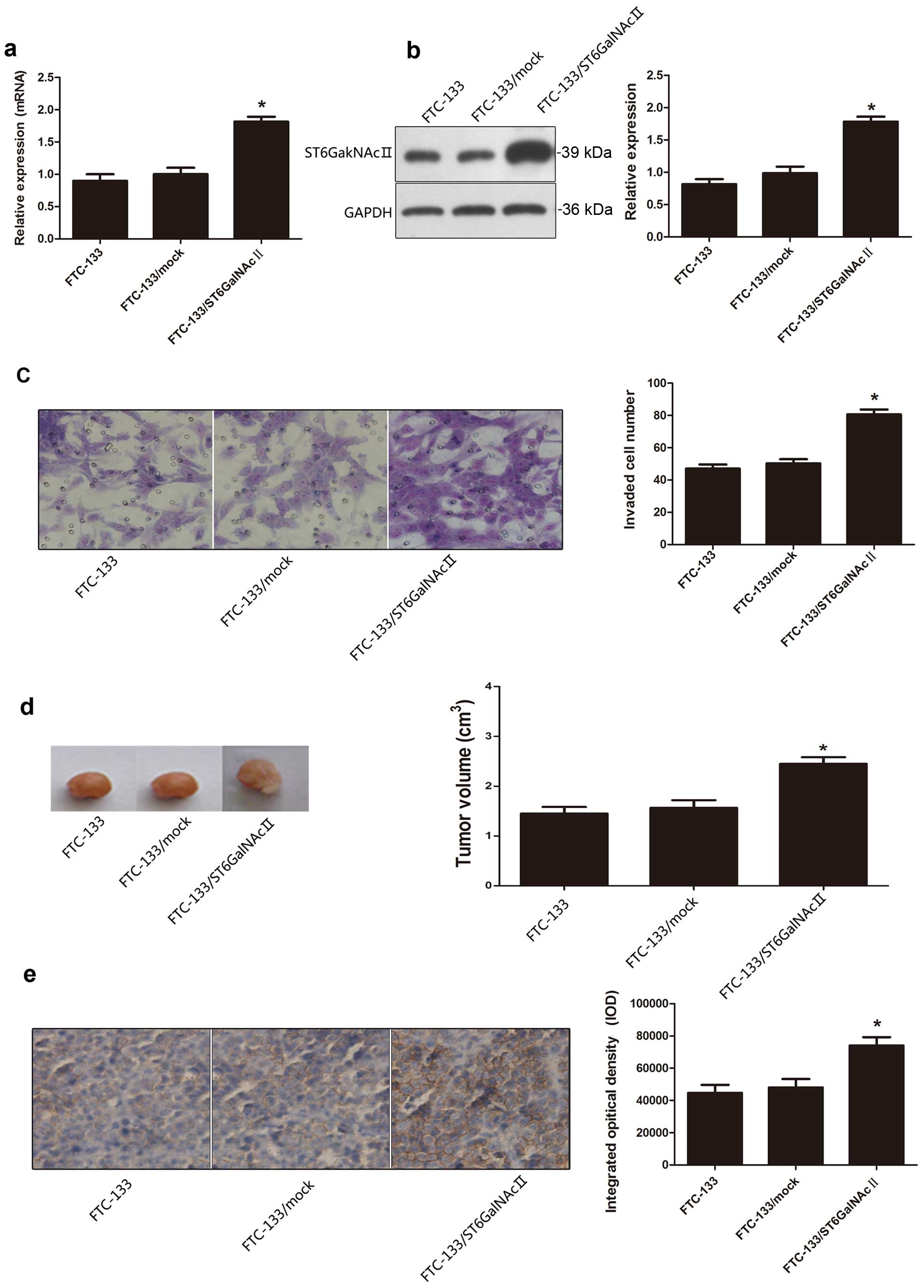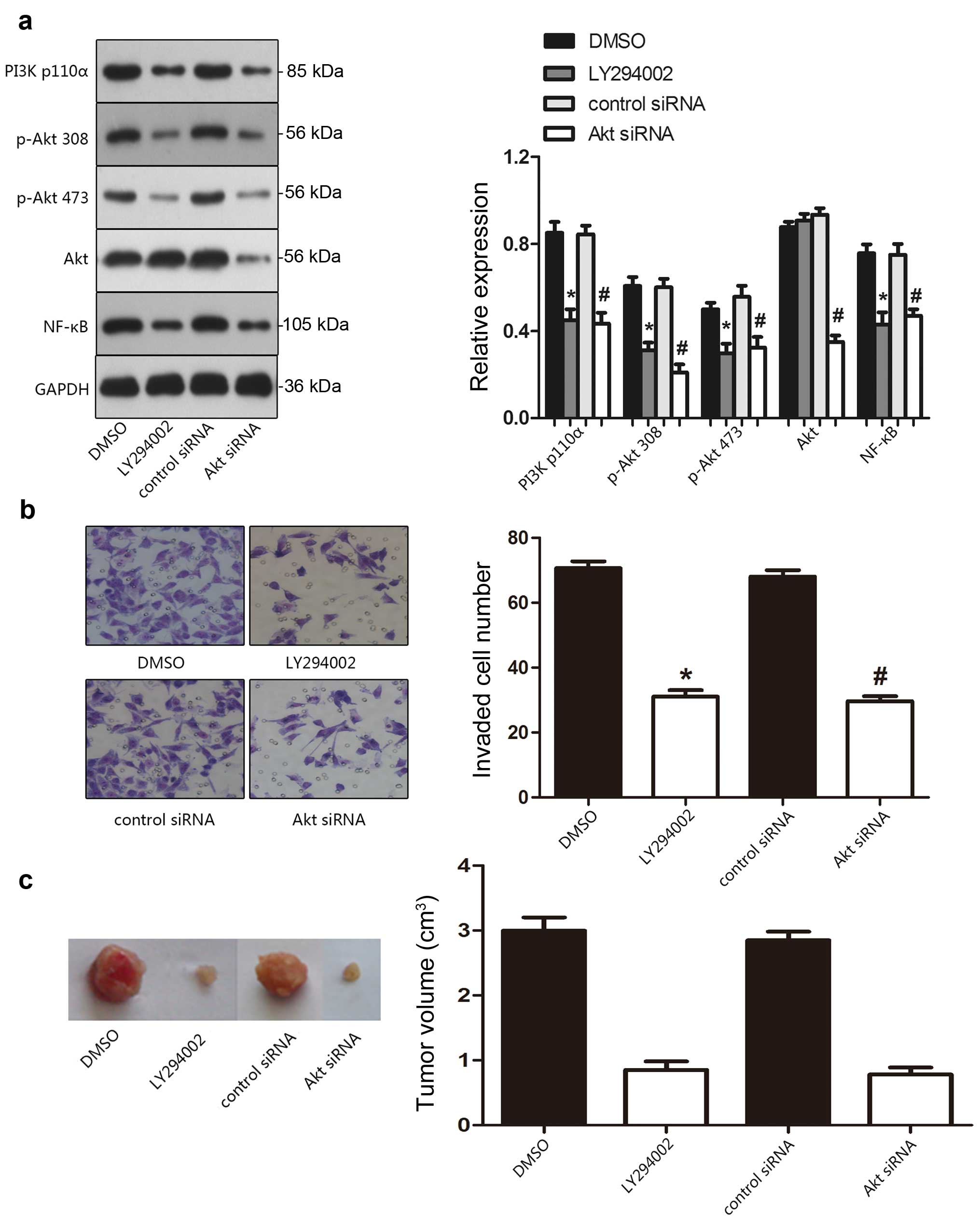|
1
|
Dall'Olio F and Chiricolo M:
Sialyltransferases in cancer. Glycoconj J. 18:841–850. 2001.
View Article : Google Scholar
|
|
2
|
Harvey BE, Toth CA, Wagner HE, Steele GD
Jr and Thomas P: Sialyltransferase activity and hepatic tumor
growth in a nude mouse model of colorectal cancer metastases.
Cancer Res. 52:1775–1779. 1992.PubMed/NCBI
|
|
3
|
Majuri ML, Niemelä R, Tiisala S, Renkonen
O and Renkonen R: Expression and function of alpha 2,3-sialyl- and
alpha 1,3/1,4-fucosyltransferases in colon adenocarcinoma cell
lines: Role in synthesis of E-selectin counter-receptors. Int J
Cancer. 63:551–559. 1995. View Article : Google Scholar : PubMed/NCBI
|
|
4
|
Yogeeswaran G and Salk PL: Metastatic
potential is positively correlated with cell surface sialylation of
cultured murine tumor cell lines. Science. 212:1514–1516. 1981.
View Article : Google Scholar : PubMed/NCBI
|
|
5
|
Dennis J, Waller C, Timpl R and
Schirrmacher V: Surface sialic acid reduces attachment of
metastatic tumour cells to collagen type IV and fibronectin.
Nature. 300:274–276. 1982. View
Article : Google Scholar : PubMed/NCBI
|
|
6
|
Ohtsubo K and Marth JD: Glycosylation in
cellular mechanisms of health and disease. Cell. 126:855–867. 2006.
View Article : Google Scholar : PubMed/NCBI
|
|
7
|
Kim YJ, Kim KS, Kim SH, Kim CH, Ko JH,
Choe IS, Tsuji S and Lee YC: Molecular cloning and expression of
human Gal beta 1,3GalNAc alpha 2,3-sialytransferase (hST3Gal II).
Biochem Biophys Res Commun. 228:324–327. 1996. View Article : Google Scholar : PubMed/NCBI
|
|
8
|
Harduin-Lepers A, Mollicone R, Delannoy P
and Oriol R: The animal sialyltransferases and
sialyltransferase-related genes: A phylogenetic approach.
Glycobiology. 15:805–817. 2005. View Article : Google Scholar : PubMed/NCBI
|
|
9
|
Takashima S, Tsuji S and Tsujimoto M:
Characterization of the second type of human beta-galactoside alpha
2,6-sialyl-transferase (ST6Gal II), which sialylates Galbeta
1,4GlcNAc structures on oligosaccharides preferentially. Genomic
analysis of human sialyltransferase genes. J Biol Chem.
277:45719–45728. 2002. View Article : Google Scholar : PubMed/NCBI
|
|
10
|
Julien S, Adriaenssens E, Ottenberg K,
Furlan A, Courtand G, Vercoutter-Edouart AS, Hanisch FG, Delannoy P
and Le Bourhis X: ST6GalNAc I expression in MDA-MB-231 breast
cancer cells greatly modifies their O-glycosylation pattern and
enhances their tumourigenicity. Glycobiology. 16:54–64. 2006.
View Article : Google Scholar
|
|
11
|
Ding JX, Xu LX, Zhu L, Lv JC, Zhao MH,
Zhang H and Wang HY: Activity of α2,6-sialyltransferase and its
gene expression in peripheral B lymphocytes in patients with IgA
nephropathy. Scand J Immunol. 69:174–180. 2009. View Article : Google Scholar : PubMed/NCBI
|
|
12
|
Xu LX and Zhao MH: Aberrantly glycosylated
serum IgA1 are closely associated with pathologic phenotypes of IgA
nephropathy. Kidney Int. 68:167–172. 2005. View Article : Google Scholar : PubMed/NCBI
|
|
13
|
Reticker-Flynn NE and Bhatia SN: Aberrant
glycosylation promotes lung cancer metastasis through adhesion to
galectins in the metastatic niche. Cancer Discov. 5:168–181. 2015.
View Article : Google Scholar :
|
|
14
|
Bos PD, Zhang XH, Nadal C, Shu W, Gomis
RR, Nguyen DX, Minn AJ, van de Vijver MJ, Gerald WL, Foekens JA, et
al: Genes that mediate breast cancer metastasis to the brain.
Nature. 459:1005–1009. 2009. View Article : Google Scholar : PubMed/NCBI
|
|
15
|
Engelman JA, Luo J and Cantley LC: The
evolution of phosphatidylinositol 3-kinases as regulators of growth
and metabolism. Nat Rev Genet. 7:606–619. 2006. View Article : Google Scholar : PubMed/NCBI
|
|
16
|
Bellacosa A, Kumar CC, Di Cristofano A and
Testa JR: Activation of AKT kinases in cancer: Implications for
therapeutic targeting. Adv Cancer Res. 94:29–86. 2005. View Article : Google Scholar : PubMed/NCBI
|
|
17
|
Tamburrino A, Molinolo AA, Salerno P,
Chernock RD, Raffeld M, Xi L, Gutkind JS, Moley JF, Wells SA Jr and
Santoro M: Activation of the mTOR pathway in primary medullary
thyroid carcinoma and lymph node metastases. Clin Cancer Res.
18:3532–3540. 2012. View Article : Google Scholar : PubMed/NCBI
|
|
18
|
Xu X, Qin J and Liu W: Curcumin inhibits
the invasion of thyroid cancer cells via down-regulation of
PI3K/Akt signaling pathway. Gene. 546:226–232. 2014. View Article : Google Scholar : PubMed/NCBI
|
|
19
|
Vu-Phan D, Grachtchouk V, Yu J, Colby LA,
Wicha MS and Koenig RJ: The thyroid cancer PAX8-PPARG fusion
protein activates Wnt/TCF-responsive cells that have a transformed
phenotype. Endocr Relat Cancer. 20:725–739. 2013. View Article : Google Scholar : PubMed/NCBI
|
|
20
|
Milosevic Z, Pesic M, Stankovic T, Dinic
J, Milovanovic Z, Stojsic J, Dzodic R, Tanic N and Bankovic J:
Targeting RAS-MAPK-ERK and PI3K-AKT-mTOR signal transduction
pathways to chemosensitize anaplastic thyroid carcinoma. Transl
Res. 164:411–423. 2014. View Article : Google Scholar : PubMed/NCBI
|
|
21
|
Geraldo MV, Yamashita AS and Kimura ET:
MicroRNA miR-146b-5p regulates signal transduction of TGF-β by
repressing SMAD4 in thyroid cancer. Oncogene. 31:1910–1922. 2012.
View Article : Google Scholar
|
|
22
|
Soula-Rothhut M, Coissard C, Sartelet H,
Boudot C, Bellon G, Martiny L and Rothhut B: The tumor suppressor
PTEN inhibits EGF-induced TSP-1 and TIMP-1 expression in FTC-133
thyroid carcinoma cells. Exp Cell Res. 304:187–201. 2005.
View Article : Google Scholar : PubMed/NCBI
|
|
23
|
Sawada M, Moriya S, Saito S, Shineha R,
Satomi S, Yamori T, Tsuruo T, Kannagi R and Miyagi T: Reduced
sialidase expression in highly metastatic variants of mouse colon
adenocarcinoma 26 and retardation of their metastatic ability by
sialidase overexpression. Int J Cancer. 97:180–185. 2002.
View Article : Google Scholar : PubMed/NCBI
|
|
24
|
Lin S, Kemmner W, Grigull S and Schlag PM:
Cell surface alpha 2,6 sialylation affects adhesion of breast
carcinoma cells. Exp Cell Res. 276:101–110. 2002. View Article : Google Scholar : PubMed/NCBI
|
|
25
|
Ren D, Jia L, Li Y, Gong Y, Liu C, Zhang
X, Wang N and Zhao Y: ST6GalNAcII mediates the invasive properties
of breast carcinoma through PI3K/Akt/NF-κB signaling pathway. IUBMB
Life. 66:300–308. 2014. View
Article : Google Scholar : PubMed/NCBI
|
|
26
|
Zhou F, Cui C, Ge Y, Chen H, Li Q, Yang Z,
Wu G, Sun S, Chen K, Gu J, et al: Alpha2,3-Sialylation regulates
the stability of stem cell marker CD133. J Biochem. 148:273–280.
2010. View Article : Google Scholar : PubMed/NCBI
|
|
27
|
Li Z: CD133: A stem cell biomarker and
beyond. Exp Hematol Oncol. 2:172013. View Article : Google Scholar : PubMed/NCBI
|
|
28
|
Zhao Y, Li Y, Ma H, Dong W, Zhou H, Song
X, Zhang J and Jia L: Modification of sialylation mediates the
invasive properties and chemosensitivity of human hepatocellular
carcinoma. Mol Cell Proteomics. 13:520–536. 2014. View Article : Google Scholar :
|
|
29
|
López-Morales D, Velázquez-Márquez N,
Valenzuela O, Santos-López G, Reyes-Leyva J and Vallejo-Ruiz V:
Enhanced sialyltransferases transcription in cervical
intraepithelial neoplasia. Invest Clin. 50:45–53. 2009.PubMed/NCBI
|
|
30
|
Wang PH, Lee WL, Juang CM, Yang YH, Lo WH,
Lai CR, Hsieh SL and Yuan CC: Altered mRNA expressions of
sialyl-transferases in ovarian cancers. Gynecol Oncol. 99:631–639.
2005. View Article : Google Scholar : PubMed/NCBI
|














